Mineral Fakes, Frauds and Scams
Mineral frauds and fakes can be found at any mineral show, large or small. This guide to common scam practice is far from complete, but it will help you to avoid being fooled by dishonest dealers.
Caveat Emptor
Whether a dealer selling these things is doing so because he's too stupid to realize that what he's got isn't real or because he knows he can make money selling such merchandise to less-knowledgable collectors. The buyer must beware! Although this article is far from being a complete guide to the hazards of buying at mineral shows, it will give you a basic idea of things to look for so that you can avoid the most common scams-and save your hard-earned money so that you can buy authentic specimens.

Varietal Names
Over the years, some minerals have been given varietal names, and these names are well-known and accepted in the mineral community. One of the best known of these are Herkimer diamonds, which are exceptionally clear quartz crystals, and the obsidian gem known as Apache Tears. Some mineral names are more like blankets: the term onyx usually refers to a variety of cryptocrystalline quartz types and is widely used when referring to material used for jewelry, particularly cameos. Also many other minerals are labeled onyx.
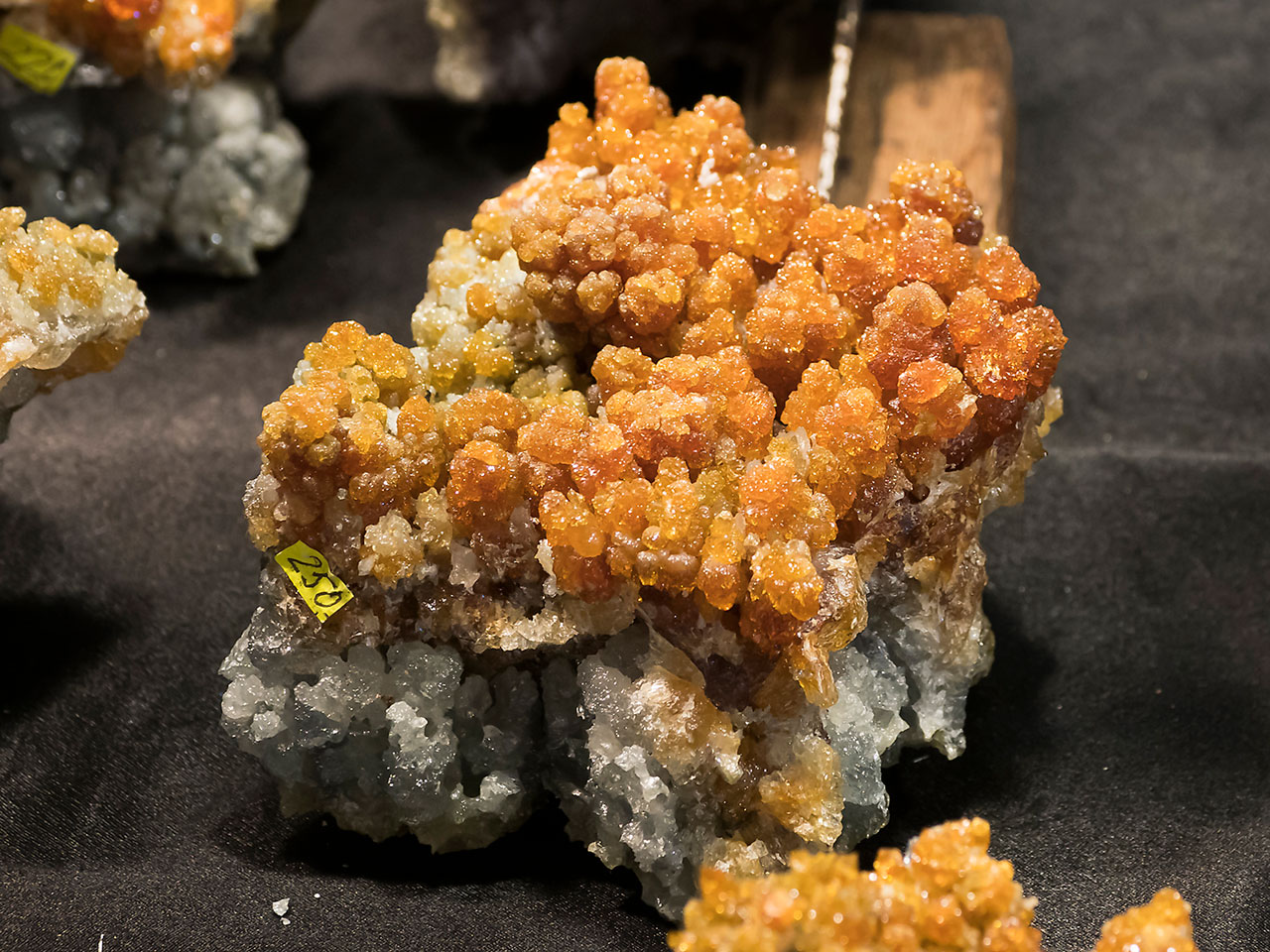
Some exist because of some historic events or because certain specific form of mineral needs to be distinguished. And some are intended to give the re-named mineral more appeal. Surely larimar sounds better than pectolite and tanzanite better than gem zoisite. There is certainly nothing wrong with that just as long as you're aware of what you're buying.
Fake Mineral Names
Scam artists take the concept of the trade name to new levels. One very common trick is to give a practically worthless mineral a super-special name. The more exotic the name, the stronger the customer's perception that the mineral has some special properties and therefore must be of greater value.
In short, the name can make an otherwise ordinary mineral appear to be something truly remarkable. And truly remarkable translates to more profit as demand for these special minerals rises.
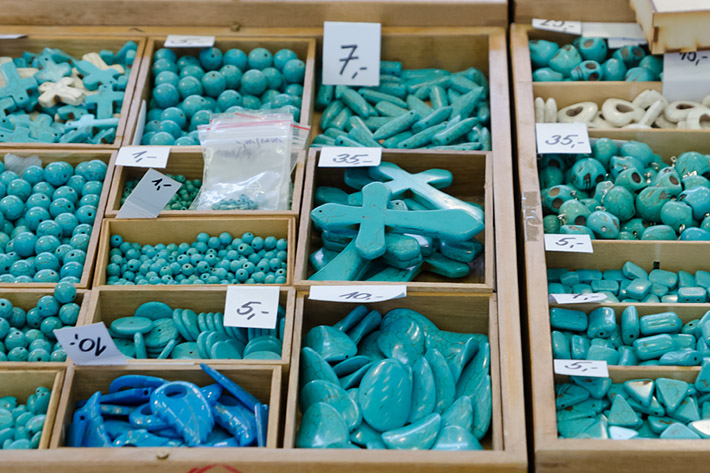
Beware minerals with exotic names like tyrkenite (fake synthetic turquoise), brazilite (just normal smoky quartz), lodonite (lab grown quartz) or azeztulite (just another quartz with a fancy name). The latter in particular demonstrates all the earmarks of fraud: a fancy name for an unremarkable mineral, special powers, and a connection to (I kid you not) extraterrestrials.
Metaphysical Powers
It is your own choice if you believe in any healing or spiritual properties of minerals. However, the dealers who cater to the New Age crowd (aka healy-feelies) are some of the most manipulative and predatory sellers you can find at any mineral show. They target these well-meaning but uninformed people (who consider themselves to be enlightened), selling specimens at wildly inflated prices and providing forged authenticity certificates for their wares.
(Editor's note: there is a difference between people who feel a connection to minerals and the New Age crowd, who think that they can buy their spirituality. Please remember this.)
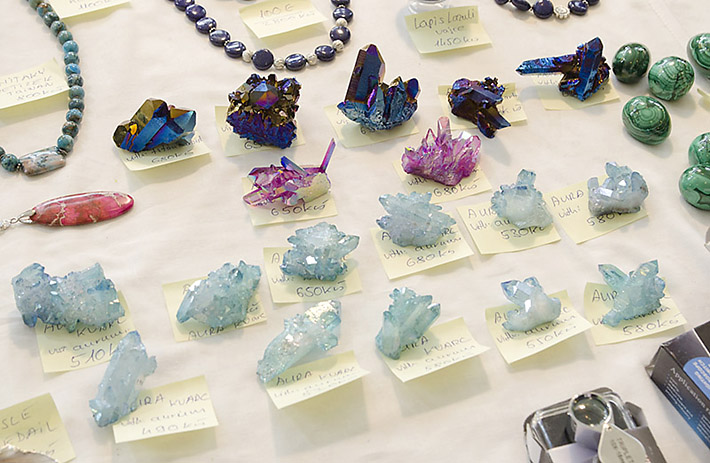
These dealers accomplish their goal of becoming rich in two ways: by assigning special powers to known minerals such as sulphur or tourmaline, or by assigning special names to ordinarily less-desirable minerals. In either case, the result is higher prices for collectors and spiritualists alike.
Look in any book on mineral properties or crystal magic and you will find names that will make you blink in disbelief. Angel Aura Quartz, Titanium Rainbow Quartz, Angel Phantom Quartz, Angel Wing Blue Anhydrite, Angelite...Really? How could anyone think that these were real mineral names?
How about Celestial Quartz , Elestial Quartz, Fairy Wand Quartz, or Dream Quartz - notice how the focus is on a common mineral in order to increase its value! Let's not forget Lemurian Seed Crystals and Trigonic Nirvana Quartz!
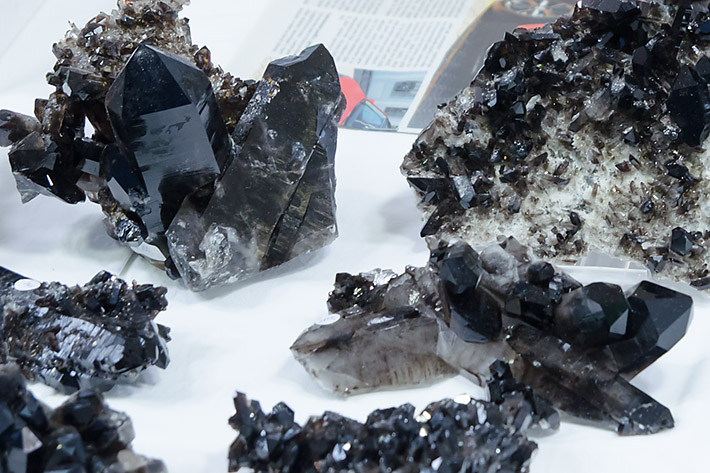
The greatest fraud of them all is Azeztulite. The New Age crowd are in love with it, and will pay dearly for it, especially if the seller provides a certificate of authenticity. Azeztulite is just common - and I mean common, as in crush it up for your driveway common - quartz that has been assigned certain spiritual properties.
Word of new minerals for spiritual use moves like wild fire in this community - in the case of Azeztulite, it is through a book written by the discoverers of this allegedly useful spiritual mineral. Called The Book of Stones, it describes the spiritual properties of everything from adamite to zoisite. A cursory examination of the book also reveals that virtually every mineral interacts in a positive fashion with Azeztulite. Imagine that. The name Azeztulite has also been copyrighted. Does that send up any red flags with you? It should!
Is Shungite a Scam?
New Age websites describe shungite as the only known natural material known to contain fullerenes, which they state are powerful anti-oxidants. Apparently it is thought that the fullerenes in this stone will cleanse water and then, as a spiritual bonus, infuse it with potent healing vibrations.
Furthermore, it is claimed that the energy embodied in shungite absorbs and eliminates anything that is a health hazard to human life and that it has other active metaphysical properties including strong healing powers.
It turns out that actual pure shungite is quite rare. Lot of shungite that can be found in New Age shops and at mineral shows is actually perhaps 1% shungite and 99% hard coal, and a great deal of it contains no shungite at all.
It is true that it can purify water, but any piece of coal - soft or hard, or even charcoal - can do the same. For $50 you can buy a piece of shungite or a truck load of soft coal: the purifying effect is almost the same. By the way, fullerenes were originally extracted from soot.
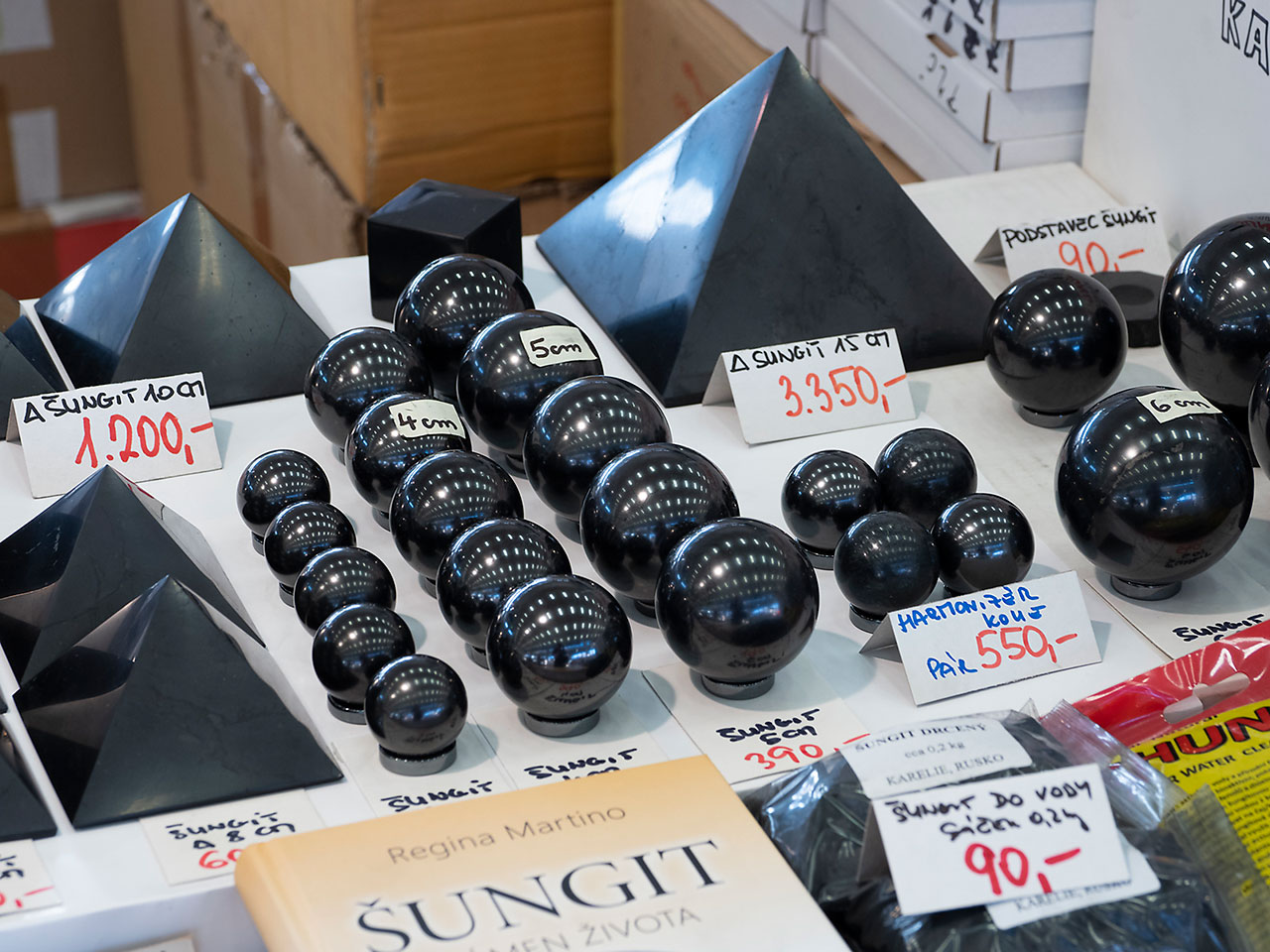
The purifying power of shungite and all kinds of coal is caused by their extremely porous structure. These pores accommodate various kinds of bad molecules of toxic substances. However, some of these - like alcohol, acids, alkali hydroxides, cyanides - are completely untouched! The industrial grade of these coal filters is known as activated charcoal. It is also used in medicine for digestion/diarrhea problems.
So is shungite a scam? If we consider real shungite and its filtering properties, then it may provide some results - like purifying water. Of course, unless you have precise structural analysis, you can never distinguish shungite from some forms of hard coal with your naked eye. If we consider shungite as an universal solution, then it is obviously scam. If you like shungite ball or pyramid, nothing wrong with that. But in case of real health problems, we highly recommend to visit a real medical doctor.
Fake Mineral Localities
Many collectors are willing to pay top dollar for specimens from classic mined-out localities. In order to capitalize on this demand, dishonest dealers buy loads of similar, less expensive minerals from highly productive mines in countries like China or Brazil and label them as being from more desirable localities.
It is very difficult for unexperienced collectors to spot such frauds, especially if the dealer has chosen his specimens wisely and has not made the mistake of making the price too low. Beware of specimens that don't look quite like the ones you've seen from a locality, or ones that are being sold at far below the prices other dealers ask. For many, however, the only way to avoid this pitfall is to buy specimens from reputable dealers.
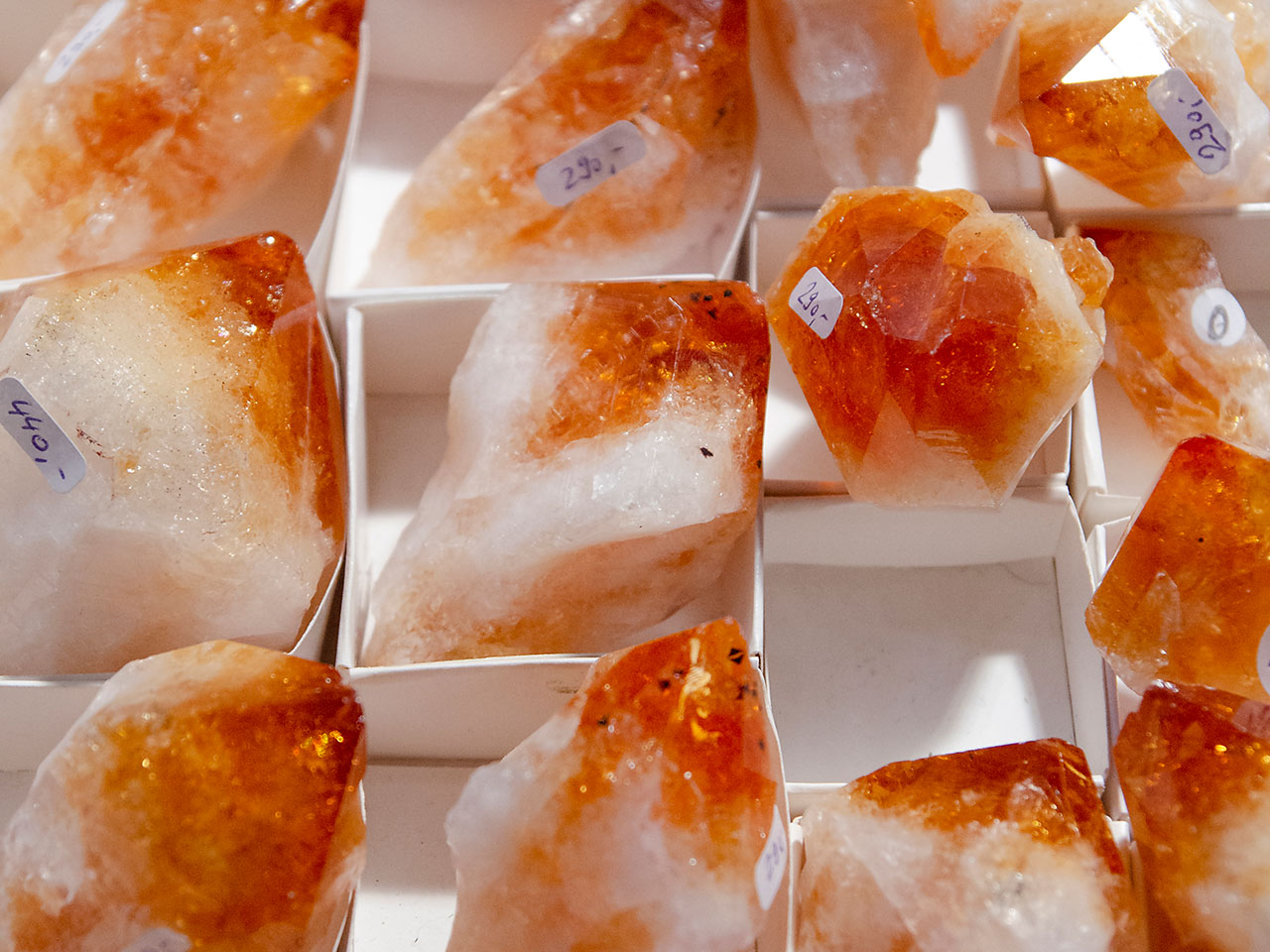
Heat Treatment of Minerals
Some minerals change their color when heated, and provide a ready source of fraudulent specimens for unscrupulous dealers. Most common among these heat treated frauds is the deep orange citrine from Brazil. Natural citrine is usually very light yellow or rarely saturated yellow: if you see a cluster of dark orange citrine, it is heat treated Brazilian amethyst for sure! I've never seen a natural citrine with such orange color. Also, keep in mind that citrines usually come from pegmatites, not from melaphyre (paleobasalt) volcanic vugs.

(Editor's note: the price for citrine of any kind is kept higher because it is a key mineral to the New Age crowd. For entertainment value, ask one of these folks if the heated treated amethyst has the powers associated with amethyst or those associated with citrine. Their heads will explode.)
Some other examples include aquamarine from Ukraine (heated heliodor) or some of the deep blue zoisite (called tanzanite) from Tanzania. Unfortuntely, the natural tanzanite also exists and there is still huge debate of how many tanzanites are genuine natural material.
Precious Opal and Water
People love the attractive colors and flash of opals, but for the inexperienced collector, buying precious opal is a mine field of fakes and frauds. Insidious dealers have found a dozen ways to take advantage of the demand for opals. Both precious and fire opals often lose their opalescence after drying, and it is very difficult to tell which ones will and which will not.
Do you see that display of opals sealed in little bottles of water? Stay away! What you see is not what you get! Another common practice is to wet the opals a day before the mineral show. The opals retain the water - and their opalescence - for a short time only. Other tricks include coating opals with nail polish, soaking them in oil or creating fake precious opals from plastic. As with other minerals, beware specimens that are allegedly from a specific locality that in this case might be noted for stable opalescence. An inexperienced buyer has only slim chance of spotting tricks like these.
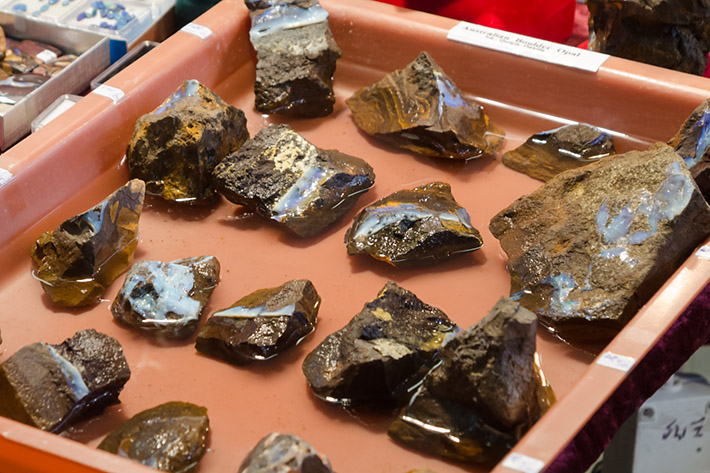
Artificially Dyed Minerals
Experienced collectors blanch at the things people do to minerals in order to sell them, and dyed specimens are enough to drive them to drink. Slices of polished agate that have been saturated with bright pink, blue or purple dyes are among the worst: just thinking about them makes collectors shudder. Even natural looking agates may be slightly manipulated in order to enhance the contrast between colors, making it difficult to get a genuine Brazilian agate - you can't be 100% sure that your agate is unaltered unless you cut it yourself.
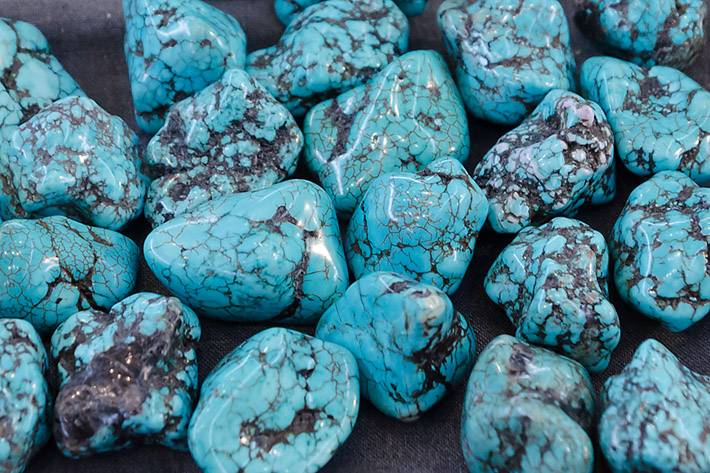
A great deal of creativity goes into scams like this: miners paint calcite clusters pink and sell them as rhodochrosite (close examination will reveal the paint).
Some faked geodes or genuine quartz geodes from China or Morocco can be also colored using pink, purple or metallic paint. Indian dealers often color white balls of okenite. Most of the turquoise on the market is dyed magnesite or howlite. Some saturated blue hemimorphite is simply dyed aragonite.
Artificial and Synthetic Minerals
Completely artificial minerals are quite widespread. These include crystals of copper sulfate (chalcantite), complex aluminum sulfates (tschermakite or cermikite), chromates, urea, industrial bismuth, silicon carbide, green/orange zincite and many others. Many sulfates are soluble in water and decompose in time; chromates, which are also soluble, are highly toxic!
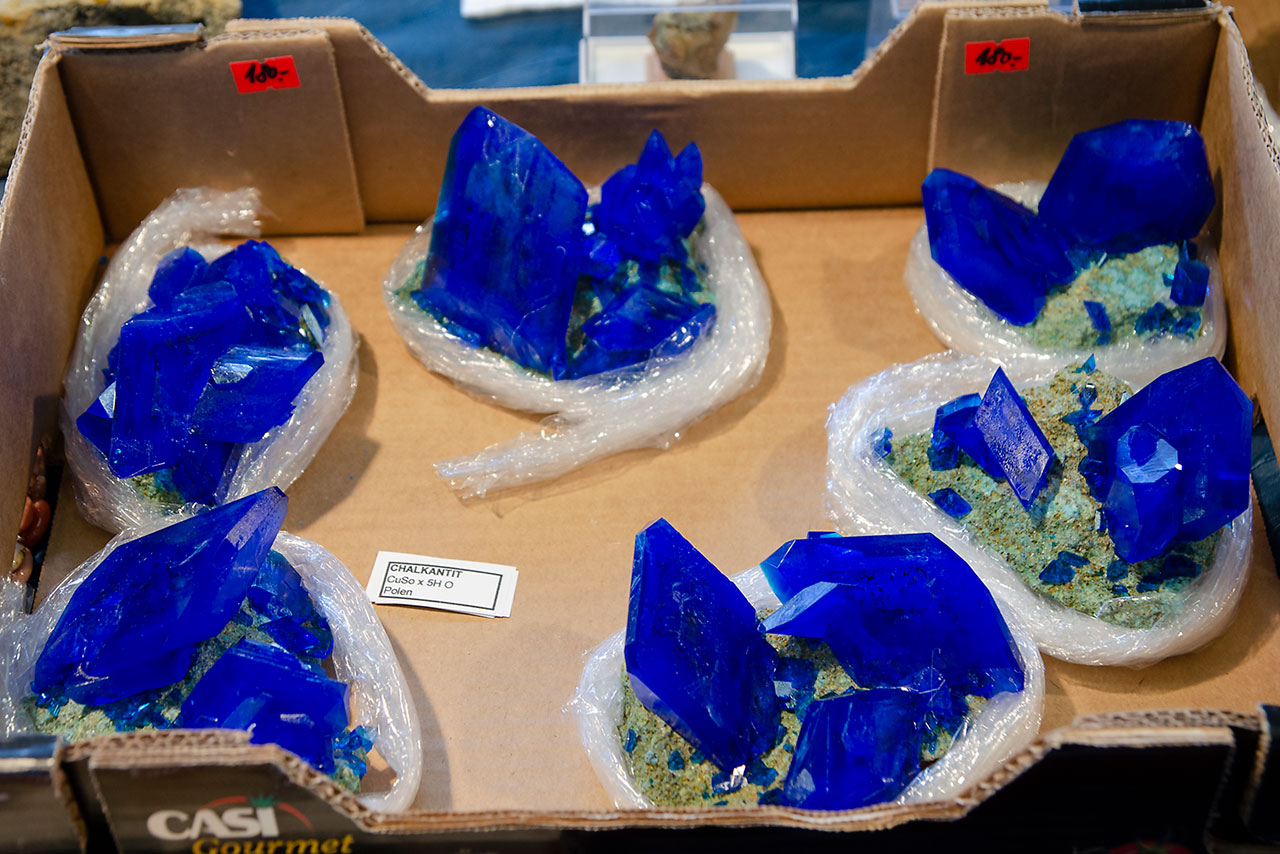
The special type of scam are faked crystals and pseudomorphs. Some gold crystals from Russia is just melted gold cast into the special form. Some malachite or copper pseudomorphs after aragonite (often originating in Peru or Chile) or calcite (Morocco) were made by soaking aragonite or calcite crystal in a copper sulfate solution. Other tricks include amber, turquoise or precious opal made of plastic, turquoise made of gypsum etc.
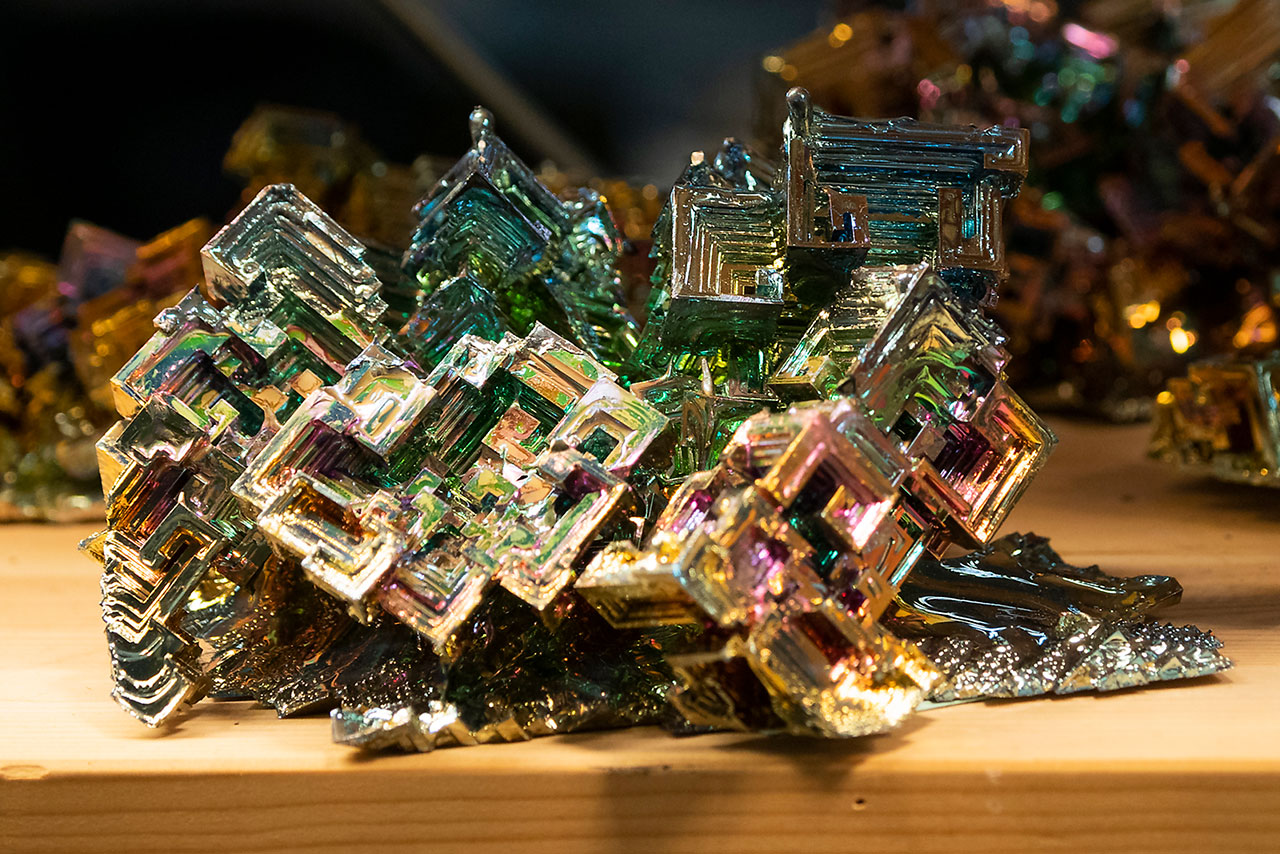
Synthetic minerals range from lab grown quartz crystals to man-made examples of gems such as zircon, emerald, ruby and sapphire. Synthetic gem diamonds do exist but they are more expensive then the natural diamonds. It is often very difficult to recognize synthetic gems without special lab tools and a great deal of experience.
Green quartz is created by putting normal low quality quartz clusters with water and color agent (typically chromium) under high pressure. Also moldavites are sometimes created from green glass or remelted moldavite chips. Some native silver wires on acathite (mostly from Imiter, Morocco) were created by heating the acanthite cluster. Some sulfur crystals from Italy are man made. Many nice copper crystal clusters were grown in copper-rich mine waters. Copper clusters and silver wires also grow in smelting factory chimneys.
Artificial Mineral Coatings
Coating minerals with metal vapors under vacuum has become very popular in last few years. The result of this process includes very popular and often overpriced junk like aqua aura quartz, titanium quartz, rainbow quartz and others. Lately, there are also things like golden kyanite and other crazy artificial products.
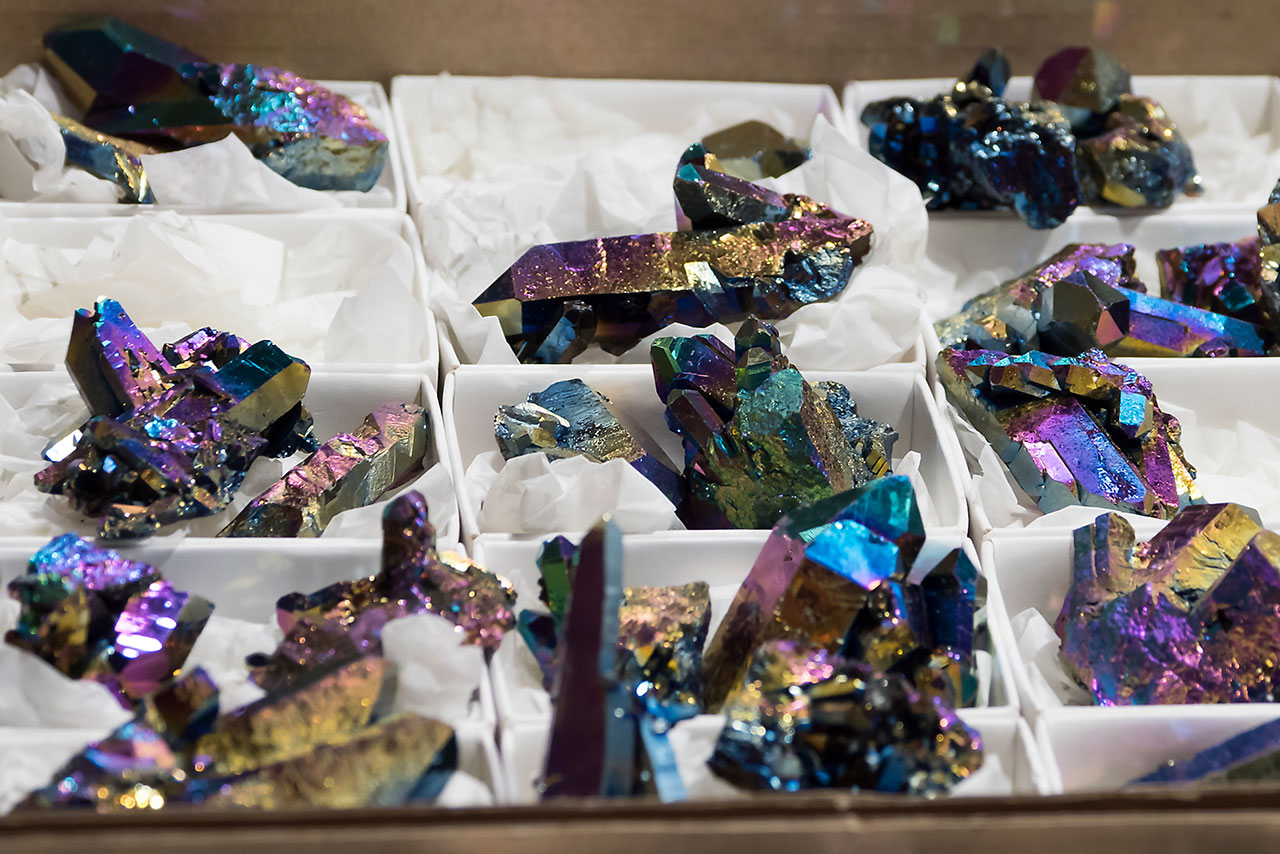
Some dealers disclose that these minerals are treated but most don't. These coated quartz clusters are especially valued by the New Age crowd (see above).
Repairs, Reinforcement and Conservation
Experienced collectors know that not all specimens are collected in pristine condition. Many crystal pockets have been damaged by tectonics or weathering or by quarrying equipment (or by the hammer of the collector.) Because of this, many minerals require some repair or conservation.
Pyrite and marcasite are typical examples of minerals which easily decompose if they are not properly cleaned and conserved. There is nothing wrong with the sale of repaired and/or conserved specimens if the repair or conservation is done reversibly and is fully disclosed. Problems occur when an old collection is sold after the death of the original owner and the information about any repairs might be lost.
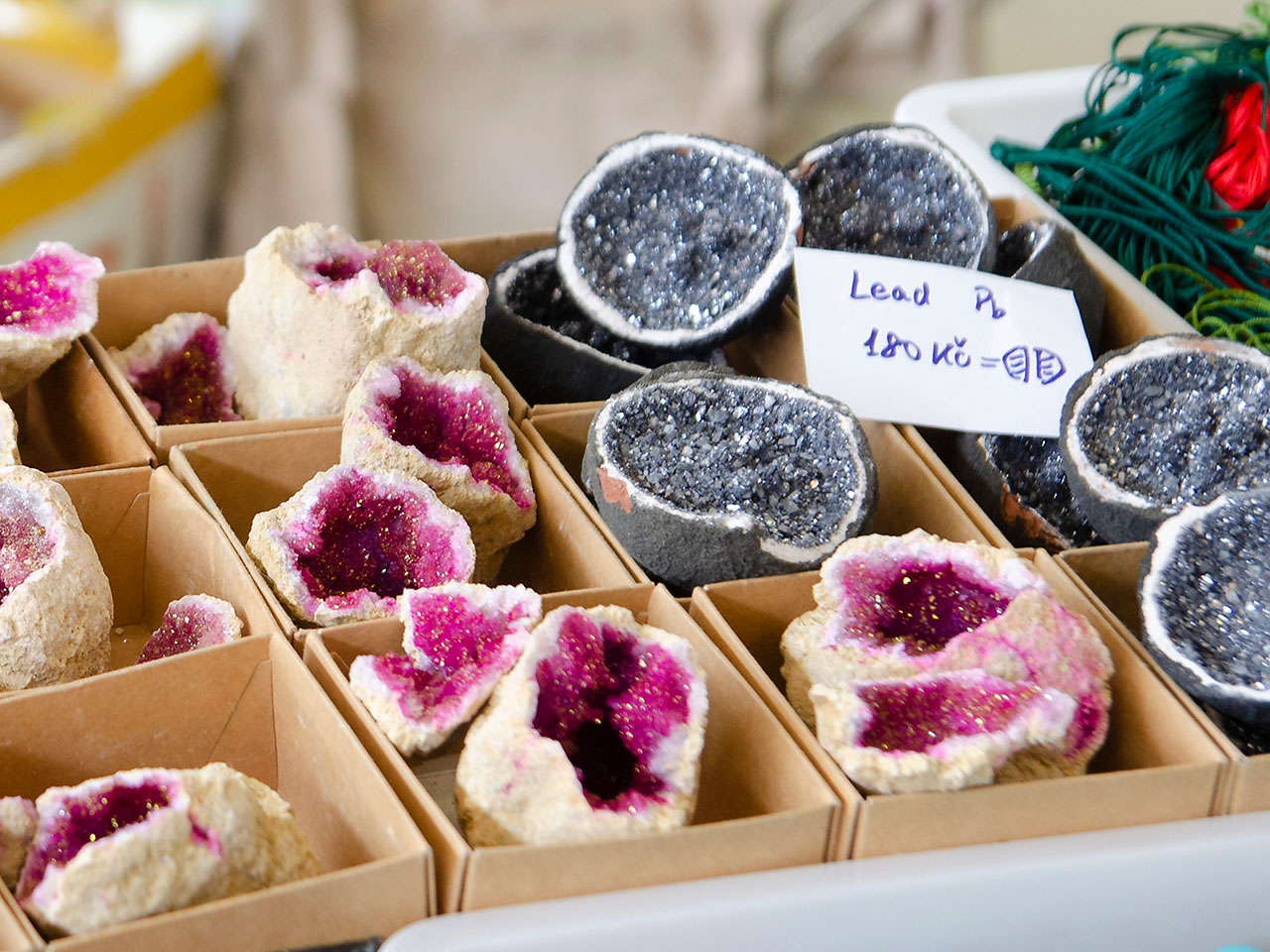
Most collectors accept repaired specimens if the repairs are disclosed. Sometimes, small chips or part of crystals are missing. A person doing reconstruction might treat these voids by filling the empty spaces with a substance like an epoxy or polymer. However, many collectors consider such reconstructions unacceptable.

Faked clusters or geodes fall into a special category. These originate in places like Morocco, China, India, or Romania. Local miners glue crystals together or to a matrix. The cluster is then covered by fine mica or crushed mineral mixed with glue. Some of these faked clusters are obvious but those that are skillfully crafted are extremely difficult to recognize. Soak the suspicious specimen in the acetone and see what falls apart. Faked geodes made of gypsum and filled with crushed galena or other eye-catching material can fool only inexperienced buyers.
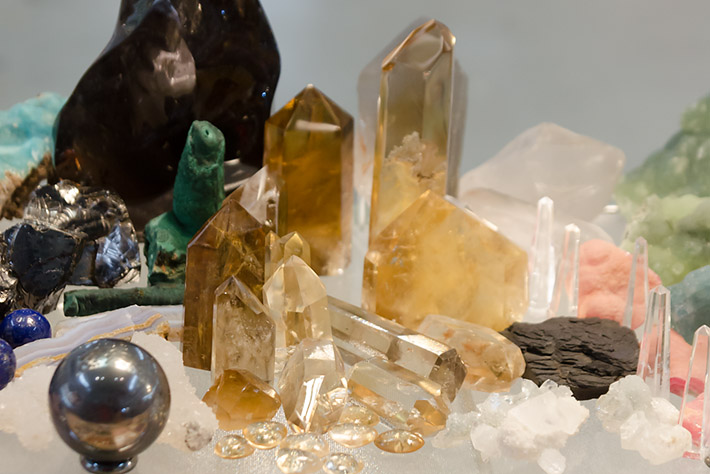
Grinding and polishing of damaged crystal faces of quartz is very common. Some crystals are in fact complete fakes cut from big quartz chunks and then polished. The same can be said for some big garnets from Africa, Colombian emeralds and Brazilian aquamarines.
Be sure to check surface of suspicious crystals: the polished surface usually has a slightly different luster, and has no growth patterns or striations (these textures are quite distinctive) and often is slightly curved.
Irradiation of Minerals
The color of many minerals is caused by tiny structural defects caused by natural irradiation. Unfortunately, some dishonest dealers cleverly irradiate their specimens in order to enhance their color.
The smoky quartz with dolomite from Turt, Cavnic or other localities in Romania is particularly famous: it used to be normal white hydrothermal quartz. Another example of irradiated specimens is the fake rubellites (pink tourmaline) from Afghanistan. Many irradiated specimens loose they color if exposed to direct sunlight for some time.
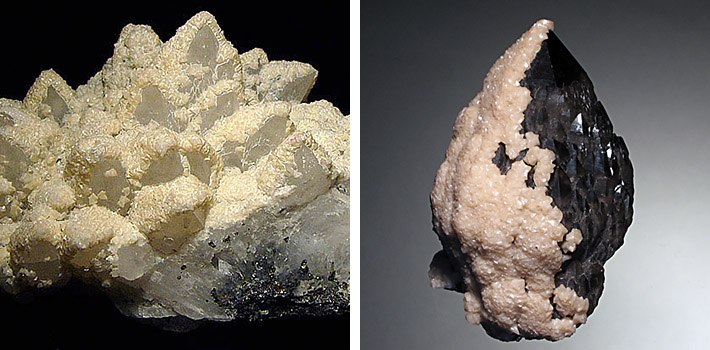
Right: Irradiated quartz 9 cm tall from the same locality. Photo: Vítězslav Snášel
Other irradiated material includes very dark smoky quartz from Arkansas (originally rock crystal) and saturated heliodor crystals from Tajikistan or Pakistan (Afghan aquamarine). The color of some blue topaz or aquamarine from Brazil; dark blue baryte from Romania or dark brown topaz from Pakistan are caused by irradiation as well.
Gem Fakes
There are so many gem frauds that it could fill a whole book: Color improvements by artificial coloring, heat treatment or irradiation. Filling internal fissures and inclusions by oil or other materials, selling synthetic gems as natural and many other tricks..
The colors of moonstone in jewelry can be enhanced by adding a coat of blue nail polish to the back of the cabochon. (Editor's note: that moonstone jewelry is mine.) Many cheap faceted stones or fakes set in jewelry have aluminum foil or silver/gold paint bellow the faceted stone to enhance its appearance.
Be extremely cautious when buying gems - both rough and faceted. Buy only from certified and trusted dealers and require that they provide all the proper documents. Buying gems directly from miners in the foreign countries is for gem experts only.

How to Avoid Buying Fake Mineral Specimen?
Mineral fakes and frauds have become so commonplace that you can see many of the treatments mentioned above at each and every mineral show you attend. I don't want to offend any honest dealer or serious mineral collector selling leftovers at shows, but buyers must stay extremely cautious and critical when they shop.

How can the average collector avoid these pitfalls? Avoid impulse buying: if a specimen is too cheap to be true, it probably isn't what you think it is. Think twice before buying that expensive specimen from a classic site.
Bring a good loupe and use it! Watch for unnaturally bright colors, unusual textures, and weird coatings on crystals. Always require a receipt or invoice for any expensive purchase. Be aware that sometimes even serious dealers get fooled by dishonest miners, so you can too. Be careful!





Comments
webmaster said:
06.06.2015 07:45:07Loved this article. Thank you!
webmaster said:
06.06.2015 10:11:09Synthetic (lab grown) diamonds are not more expensive than natural diamonds-you have it backwards-natural are more expensive than synthetic!
webmaster said:
08.06.2015 19:10:00Synthetic GEM QUALITY diamonds are more expensive then natural. Of course technical synthetic diamonds are cheaper then natural and the production is skyrocketing in last few years. Most of the synthetic technical diamonds are produced in China.
webmaster said:
06.10.2015 18:12:15Bardzo dobry i odważny artykuł. Wielu, nawet kolekcjonerów nie mówi o tym głośno. Napiszę o tym na naszej stronie. Dziękuję i pozdrawiam.
webmaster said:
07.10.2015 21:17:59Can I have permission to use this article in the club newsletter, The Pelonagram?
webmaster said:
08.10.2015 02:57:34Great article. I have just become aware of this through some forums. The stones I have purchased have been through US mines out of Montana and North Carolina. All the Stones appear to be real rough that I cut. But I very rarely find clarity without some sort of flaw. That is what makes me believe that most the stones i see are fake or have been treated some way or some how. All the stones I have cabochon have flaws and are not perfect but still very beautiful to the admirer. Great article. My question is, if a dealer says the stone is a AA, is that good?
webmaster said:
08.10.2015 05:03:35Does anyone know where the moldavite comes from? I know it can be created after an atomic blast and I have been wondering if any of that moldovite is on the market?